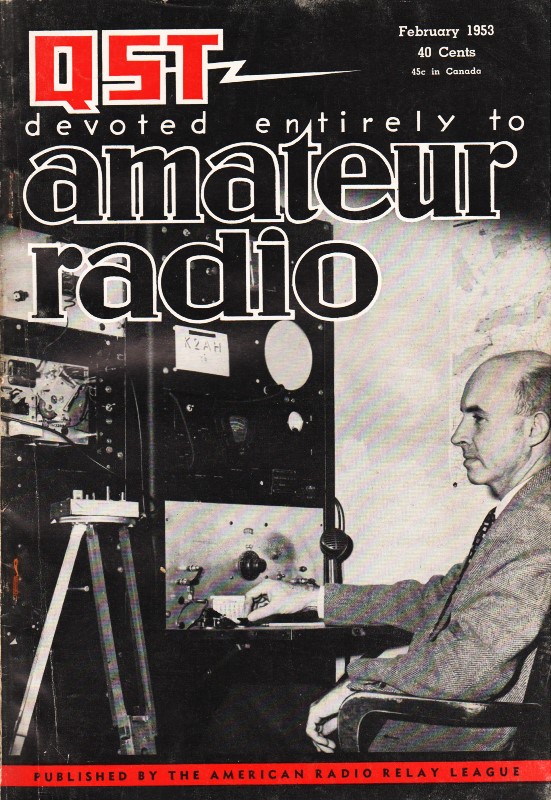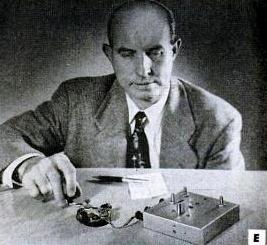
Februay 1953 QST showing K2AH and the first transistorized amateur transmitter. The transmitter itself is atop the tripod.
As far as I’ve been able to determine, the first mention of a transistor appeared in QST in June 1952 as a stray. The item reported as follows:
Amateurs whose forte is light, compact portable equipment will be interested in trasistor-technique progress reported by the Army Signal Corps. A “transistorized” radioteletype converter unit has been built which uses one-hundredth the current drain and weighs one-tenth as much as comparable vacuum-tube equipment now in service. Estimated life of the type of transistor used in the new converter is seven years for 24-hour-per-day use.
It wasn’t long until the first transistorized amateur radio transmitter showed up. It was reported in QST, January 1953. That issue’s World Above 50 Mc column noted that the transistor was “destined to have far-reaching effects on the science of electronics, but so far it had created no great stir in amateur circles.”

K2AH and his transmitter. Popular Mechanics, May 1953.
The change came when George Rose, K2AH, of Mountain Lakes, N.J., worked W2KNI, W2DPB, and W2UK with “what was unquestionably the first amateur transistor transmitter, and probably the world’s record for low transmitter power.” The transmitter was pictured on the cover of the February 1953 issue and described in detail in an article by Rose in the March issue, entitled “The Transistor–Or 25 Miles on a Hunk of Germanium“. Rose begins the article:
Most hams who can qualify for the Old Timers Club remember with mixed feelings the time spent per evening searching for that elusive spot on their pet piece of galena which would bring in NAA at a readable level, if not exactly loud and clear. Neither they nor anyone else knew why or how the thing worked in the first place. When tubes finally became commercially and financially available it was the general hope that galena and its sister crystals silicon, carborundum, etc., would be properly disposed of. They did practically vainish from the electronic scene until World War II when silicon diodes were found to outperform tubes as microwave mixers.
And since Rose was the manager of advanced development at the RCA Tube Department, he was in a position to bring home a prototype transistor to put on the air. He chose 146 MHz for the first transistorized transmitter. Even though transistors for lower frequencies were less challenging, the use of 2 meters allowed him to use his 12 element beam to get the 30-50 microwatt signal to travel a reasonable distance.
The transistor used was a PNP point-contact transistor with two phosphor-bronze cat whiskers touching a piece of germanium, separated by less than a thousandth of an inch. The original transmitter is apparently still in existence and can be seen at this link at a 2010 Antique Wireless Association meeting.
A Stray in the April 1953 issue reports on the first QSO with a transistorized transmitter on both ends. In this case, W2JEP and W2TYH made a QSO of a half mile on 40 meters, each running about 60 milliwatts and the signal reports were S8 or S9, and the authors noted that the signals probably would have been readable at a much greater distance.
The first fully transistorized station (both transmitter and receiver) was reported in the June 1953 issue. This station consisted of a two-transistor 10 meter AM transmitter and a two-transistor superregenerative receiver. The station made contacts with mobile stations at a club meeting within a radius of a half mile. The Stray notes that the receiver was that of W2ZKE, with other participants being K2AQM, W2GFE, W2GNE, W2NOH, W2YCX, W2YTH, and W2ZKE.
(Note: To view the QST articles linked above, you must be logged in to your ARRL account.)
Click Here For Today’s Ripley’s Believe It Or Not Cartoon ![]()
